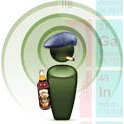Running Windows XP, fancy a change of scene, then download the newly released Zune theme from Microsoft. To my eye, it’s a less juvenile colour scheme than the standard XP theme with its primary colours etc.
Zune theme
There’s a totally pointless video on the web showing you how to install it, but all you have to do is click that link, save and run the MSI file and then hit “Apply” as and when.
Of course, if you’re on Linux or Mac you probably couldn’t care less about the latest XP theme, but if you’re on XP and have people walking by your desk on a regular basis you could probably persuade some of them at least that you’ve got Vista already, without having to actually install it. Or maybe not.
Is the “old” XP them too garish? Have you installed the Zune theme? What do you think of it? Are the desktop and taskbar items as clear as they are in the original?
 Infrared and NMR spectroscopy have possibly revealed one of the great secrets of the violin makers Stradivari and Guarneri del Gesu – they used chemical wood preservatives to help preserve their instruments and to improve the tonal quality. The discovery could help modern-day violin makers emulate more closely the properties of irreplaceable violins from the 18th Century and well as providing music conservationists with new insights on how to best preserve the antique instruments.
Infrared and NMR spectroscopy have possibly revealed one of the great secrets of the violin makers Stradivari and Guarneri del Gesu – they used chemical wood preservatives to help preserve their instruments and to improve the tonal quality. The discovery could help modern-day violin makers emulate more closely the properties of irreplaceable violins from the 18th Century and well as providing music conservationists with new insights on how to best preserve the antique instruments. A new study reveals that the static snapshots recorded in protein crystallography may be missing the bigger picture. Investigations of a bacterial protein using cryomicroscopy shows the protein in a balloon-like mode previously hidden from sold state studies. The discovery suggests that techniques complementary to X-ray crystallography are essential if molecular biology is to gain a complete understanding of protein structure.
A new study reveals that the static snapshots recorded in protein crystallography may be missing the bigger picture. Investigations of a bacterial protein using cryomicroscopy shows the protein in a balloon-like mode previously hidden from sold state studies. The discovery suggests that techniques complementary to X-ray crystallography are essential if molecular biology is to gain a complete understanding of protein structure.  Breast cancer remains the most common form of cancer among women but screening with mammography involves exposure to ionising radiation and suffers from a high rate of false positives that then require a definitive assay. In the December issue of the journal Biopolymers, researchers in India describe how Raman spectroscopy might be used to discriminate between normal, benign, and malignant breast tissue and so provide a simple and relatively non-invasive complement to a suspicious mammogram.
Breast cancer remains the most common form of cancer among women but screening with mammography involves exposure to ionising radiation and suffers from a high rate of false positives that then require a definitive assay. In the December issue of the journal Biopolymers, researchers in India describe how Raman spectroscopy might be used to discriminate between normal, benign, and malignant breast tissue and so provide a simple and relatively non-invasive complement to a suspicious mammogram.  Asthma sufferers, non-smokers, and those who really just don’t care for passive-smoking-induced lung cancer can breathe a long sigh of relief as England follows other enlightened states and places a ban on smoking in enclosed public places, such as pubs, clubs, and restaurants, from July 1, 2007.
Asthma sufferers, non-smokers, and those who really just don’t care for passive-smoking-induced lung cancer can breathe a long sigh of relief as England follows other enlightened states and places a ban on smoking in enclosed public places, such as pubs, clubs, and restaurants, from July 1, 2007.